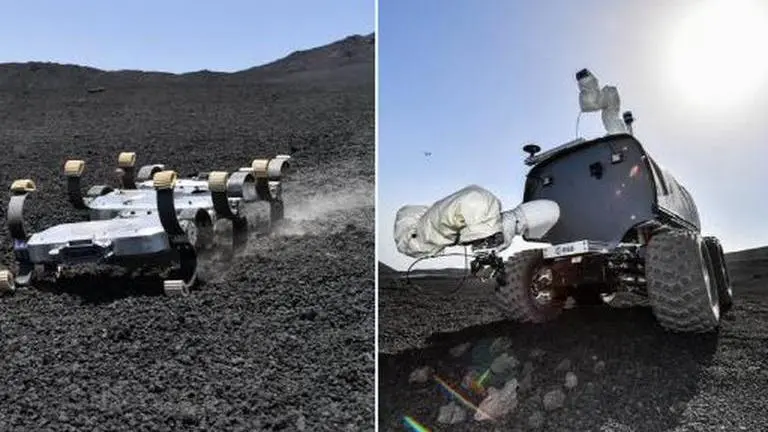Updated 3 July 2022 at 16:22 IST
German space agency completes robotic tests on Mount Etna volcano inaccessible to humans
The German Space Agency concluded its Autonomous Robotic Networks to Help Modern Societies (ARCHES) on the Mount Etna volcano in Italy.
- Science News
- 2 min read

Robots are capable of treading in areas inaccessible to humans, and this was proven during recently concluded tests by the German Space Agency (DLR). During the Helmholtz Future Project, Autonomous Robotic Networks to Help Modern Societies (ARCHES), the agency tested a range of robots on Italy's Mount Etna volcano, which has some geographical similarities with the Moon, such as the lava landscapes and granular surface. Interestingly, these tests involved a wide range of robotic systems which acted as the hands and eyes of scientists controlling them remotely.
Mission accomplished! ✅ The live demo week for the @helmholtz_de future project #ARCHES22 has come to an end. The different #RobotsOnEtna successfully cooperated to independently carry out tasks such as taking & analysing rock samples & placing hardware:https://t.co/c88rnhO2tw pic.twitter.com/S6iAjEGCDl
— DLR - English (@DLR_en) July 1, 2022
Objective of the tests
The primary objective of the tests is to develop technologies that would allow exploration in areas that would be inaccessible to humans. During the demonstrations on Mount Etna, the deployed robots including rovers collected rock samples, analysed them and forwarded the results to their control center. This was done under the first scenario, named 'Geological Mission I', among three in total. And since the geography was similar to that of the Moon, it presented realistic challenges for lunar exploration missions to be conducted later this decade.
(Image: German Space Agency)
The 'Geological Mission I' involved two autonomous robots -- Lightweight Rover Unit 1 (LRU1) and LRU2-- which were accompanied by a drone. While the 'scientist' LRU1 robot evaluated soil samples using its cameras, its 'assistant' LRU2 collected surface samples and analysing them by breaking them down using lasers.
Advertisement
(Image: German Space Agency)
The German space agency said that all three scenarios were based on different overall conditions. For instance, in the first scenario, German astronaut Thomas Reiter controlled the robots from a special control room about 23 kilometres from Mount Etna. Whereas in the second scenario, which marks the conclusion of the European Space Agency's (ESA) 'Analog-1' campaign, a rover was controlled from the International Space Station (ISS) in 2019.
Advertisement
(Image: German Space Agency)
In addition to this, the third scenario named the 'LOFAR Experiment' involved simulating the installation and maintenance of a low-frequency radio antenna array on the far side of the Moon, the side which is not visible from Earth. DLR says that the focus of their ARCHES project is to advance in the area of space, robotics and ultimately planetary research.
Published By : Harsh Vardhan
Published On: 3 July 2022 at 16:22 IST



